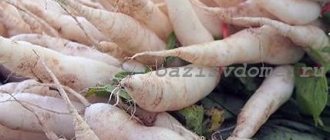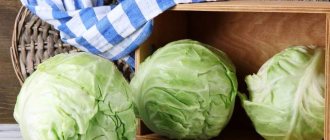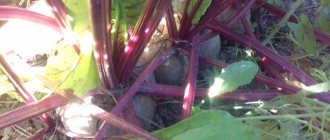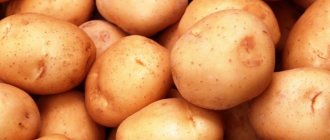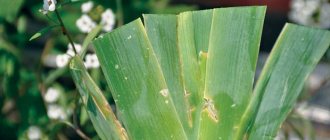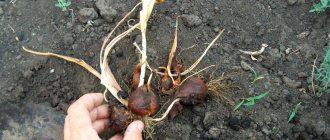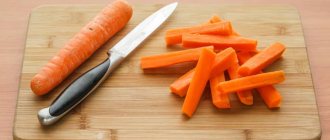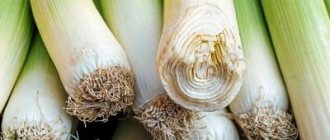When to remove daikon from the garden in the fall
Japanese radish is a heat-loving crop. Therefore, all gardeners and summer residents should carefully monitor the long-term weather forecast, because only high-quality crops can be stored. If there is a threat of early frosts, daikon is harvested even when unripe according to the dates indicated on the package. Most varieties are root crops that protrude high above the soil surface and do not tolerate temperatures below 0 °C. Specimens damaged by frost cannot be stored; they quickly deteriorate. Based on the weather in their area, everyone decides when to harvest vegetables: in September or October.
Non-bitter radishes will taste better if they are fully ripe. This factor also affects keeping quality. If the temperature drops too early and for a short time, a spunbond shelter is built for vegetables that will be stored in winter. During the day, the material is removed so that the plant absorbs solar heat.
Dig up daikon for storage in cool, dry weather. The rows are deeply loosened to make it easier to free the vegetables from the soil. Root vegetables growing in a light and loose substrate freely emerge from the ground if they are pulled by the tops and top of the vegetable itself. First, they try to rock it in the ground from side to side or clockwise. If the root gives in, apply more force and pull it out of the nest. In compacted soil, dig with a fork or shovel so as not to damage the juicy and fragile structure of the pulp when pulling out.
When to harvest daikon in the Moscow region
Sweet radishes in regions where temperatures drop early sometimes have to be dug up before they are fully ripe. But it is better to harvest daikon a little smaller than those damaged by frost. The roots will not be the stated size, but if stored properly they will last for several months. The taste and beneficial qualities do not change radically. If frosts are short-term, the bed is covered with agrotextiles or film with insulation.
Attention! After harvesting, the daikon crop is inspected and those root crops that have cracks, scratches or spots on the skin are discarded.
Such copies cannot be stored. If the vegetables are not affected by rot, they can be used immediately in cooking.
Selection of planting material
There are many varieties of daikon, both domestic and native to Japan. Their choice depends on whether you are going to store the daikon or eat it straight away. If the appropriate conditions are created, some varieties can be stored for up to six months. In the middle zone, a good harvest can only be obtained by sowing early and mid-ripening varieties. Late ripening ones simply will not have time to form a large harvest. For loose, light soils, daikon varieties with any size of root crop are suitable; on heavy, dense soils, it is better to take those that produce a small oval or round vegetable.
How and when to plant
This unpretentious vegetable has a feature that gardeners sometimes forget about: it is a plant with long daylight hours. If the duration of the light period is more than 13 hours, the plant forms not a root crop, but generative organs: a flower arrow, and then seeds. Incorrectly chosen sowing time is the main reason for failure in cultivating this valuable root crop.
By this time, some vegetables have already finished their growing season and are removed from the beds: winter garlic, onions. In their place, the daikon will be very happy.
To form a full-fledged harvest, Japanese radish needs a large feeding area. The planting scheme for varieties with small and medium-sized root crops is 30x50 cm. Large-fruited varieties are sown according to a 40x50 cm scheme; for varieties with long root crops of small diameter, the distance between rows can be made smaller - 40 cm.
Usually 2-3 seeds are sown in one hole to a depth of about 2 cm. The soil should be moist. After germination, excess plants need to be carefully trimmed; if they are not close to each other, they can be replanted. By the way, young daikon leaves are very good in salads. To get seedlings faster, the seeds are prepared in the same way as for sowing seedlings, and the bed itself is covered with non-woven material. The same is done when planting seedlings, but the soil around the plants must be mulched with a layer of hay, straw, and dried grass without seeds.
Planting dates before winter
A close relative of the daikon, the radish has long been sown before winter. The result is an early harvest of strong and strong plants. You can also sow daikon before winter. It will produce a harvest in the spring without growing seedlings. For sowing, select only early ripening varieties that are not prone to bolting; the rest will bloom with the onset of spring warmth. The exact timing of winter sowing is determined by the weather, since it is carried out after the onset of persistent frosts in the frozen ground. The beds for it are prepared in warm weather, preparing dry soil or humus for sprinkling the seeds. It is better to keep them indoors. The bed must be completely ready for sowing: dug up, fertilized, rows outlined.
They also mulch the entire surface of the bed. In the spring, the mulch should be raked into the rows, and the bed should be covered with a film thrown over the arches so that the soil warms up faster.
Rules for storing daikon for the winter
The good keeping quality of Japanese radish depends on the quality of harvesting. Dug up root vegetables, which will be stored for several months, are left in the garden for 4-5 hours so that the soil on the skin dries out. If the day is warm and sunny, vegetables are transferred to a shaded place for drying. Then the soil is carefully shaken off and removed, but not with a sharp tool. It's better to wipe it with a cloth. The tops are trimmed, leaving the tops up to 2.5 cm long. Root crops that meet the following requirements are stored:
- elastic, not flaccid – the density of the structure is felt;
- the skin is naturally white, greenish-cream, or tinged pink in some varieties.
Specimens with dark spots or mechanical damage are not suitable for long-term storage.
Load vegetables into containers for transportation carefully to maintain good pulp condition. Daikon should not be washed for winter storage. First, the root crops are kept for 2-3 days. During this period, hidden damage will appear. Such specimens are left for food; they can last up to 3 weeks without major signs of spoilage. Japanese radish is placed:
- in basements;
- in cellars;
- on an insulated loggia or balcony;
- in a refrigerator.
Important! The storage temperature of daikon is in the range from +1 °C to +5 °C.
Cleaning time
In early-ripening varieties of Japanese radish, root crops are formed within 30-35 days, in mid-ripening varieties - after 60-70 days, and in late-ripening varieties - after 90-120 days. 15-20 days before harvesting radishes, you can fertilize with ammonium sulfate, which promotes the formation of a rounded lower part in root crops and improves the quality of the peel, depending on the early maturity of the variety.
List of factors that determine the timing of cleaning:
- characteristics of the planted variety;
- time of planting in the soil;
- soil condition;
- weather;
- growing region.
For the Moscow region, Central Russia and other regions
Harvest dates depend on the region and time of planting. There are summer and winter daikon, but these names are conditional, because the first is planted in the spring and harvested in the summer, and the second is planted at the end of summer and harvested in the fall.
Advice
The harvest harvested in the autumn is usually larger than that harvested in the summer.
Daikon is a short-day crop that requires a lot of water, which is abundant in early autumn.
| Region | Timing of sowing seeds | Harvesting |
| Moscow region and middle latitudes |
|
|
| Krasnodar region |
|
|
| Ural and Siberia | End of July. | September October. |
| Sakhalin and the Far East | End of July – beginning of August. | September October. |
How to store daikon in the cellar for the winter
The roots are placed in rows in boxes with sand or sawdust, which are moistened as they dry. Otherwise, these materials will draw moisture from the fruit. From time to time, when storing daikon in the cellar, the root crops are examined and specimens are selected for signs of rot so that they do not infect the rest of the crop. The boxes are covered with dense material so that air access remains. You can qualitatively preserve daikon for the winter in a cellar where the air humidity is 70-90%.
Diseases and pests
The very first and main enemy is the cruciferous flea beetle, it greatly damages the leaves. To repel, use ash, which is sprinkled on the damp soil in the garden. To prevent its occurrence, many gardeners recommend planting daikon along with onions. This can be done in a checkerboard pattern. In May, you need to plant onions at a distance of 20 cm from each other. And after 1-1.5 months, plant daikon seeds. By this time, the onion greens will noticeably grow, the smell of which miraculously repels the pest. You can also use an infusion of hot red pepper for watering.
Another lover of daikon are wireworms. They significantly damage the pulp of the root vegetable, making numerous holes; such vegetables will be practically unsuitable for storage. It is very difficult to get rid of wireworms, since, as a rule, all the soil on the site becomes infected.
The wireworm is the larva of the click beetle. To destroy it, you need to plant legumes and mustard after the main crop from the site has been harvested. Adding pine needles to the soil in spring helps. Late autumn plowing of the garden, when frosts have already begun, is also effective. This helps destroy the larvae.
How to store daikon in the basement
Properly dug up and dried root crops, intact and without damage, lie well in basements. Japanese radishes are stored together with beets and carrots, or in large boxes filled with sand. If possible, line the boxes with moss. For good storage you need a humidity of 70-90% and a temperature not higher than + 5 °C. Sand is sprayed if it dries out.
Features of agricultural technology
Daikon is a close relative of the common radish. One would think that it should be planted and grown in the same way, simply by sowing the seeds in a garden bed: after all, after 2.5-3 months the root crops are ready for harvesting. However, Japanese radish has one peculiarity: this cruciferous plant is a “long-day” crop. Consequently, in the middle of summer, buds are especially successfully set and flowering begins to the detriment of the formation of root crops. Therefore, it will not be possible to get a harvest from sowing seeds in the garden in the spring: the growth period of the root crop should be in spring or autumn. Based on this, daikon is sown in open ground no earlier than the end of July, when the length of daylight hours decreases. Then, by the end of the gardening season, it will form large, tasty root vegetables. If there is a need for an early harvest, by the very beginning of summer, daikon must be grown through seedlings.
How to preserve daikon for the winter at home
In the absence of underground storage facilities, Japanese radish is also placed in residential buildings, ordinary apartments, where there is a place with a temperature no higher than + 7 °C. A few roots can be wrapped in plastic bags and placed on the bottom shelf of the refrigerator. Before severe frosts, below - 15 °C, storing daikon for the winter at home is possible even in an unheated shed. The fruits are placed in a canvas bag or wrapped in cloth and placed in a box, which is covered with an old blanket.
In private residential buildings, closets without heating are installed in which vegetables and fruits are stored. Among them there is also room for a box of Japanese radish, which with its vitamin composition will support the family in late autumn and early winter.
Attention! Only careful cleaning of daikon and careful transportation will ensure it has a long shelf life.
How to store daikon in a city apartment
If there is a balcony or loggia, root crops are placed in these rooms, having organized good insulation of the boxes with the harvest. Vegetables are stored in containers for which they use felt or modern construction insulation, or polystyrene foam. Each root is carefully placed in a box, which is also carefully closed on top. In such conditions, it is unlikely that it will be possible to preserve daikon for a long time in winter, but at temperatures down to -10 °C, you can count on the vegetables not being damaged. You can additionally protect daikon from frost by wrapping each vegetable in foil, cling film or plastic wrap. Old winter clothes and blankets are used for shelter. With the onset of severe frosts, the remaining root vegetables are transferred to the refrigerator. They can be stored on an insulated balcony for a long time.
Advice! There is another option for storing daikon - dried.
The vegetable is cut into slices and passed through a dryer. The finished product is stored in tightly closed glass jars. Used for soups.
How to store daikon in the refrigerator
If you are going to store the roots in a household refrigerator, they are also not washed. Japanese radish is left for 4-5 hours to dry out the earthen lumps, which are then shaken off by hand or wiped with a soft material. Prepared root vegetables are placed in perforated plastic bags to ensure air circulation.
Daikon can be stored in the refrigerator for up to 3 months. The roots should be periodically removed from the bag and inspected for signs of rot. The damaged copy is removed. Even spring-planted daikon can be stored in the refrigerator for a month or a month and a half, although its flesh is usually softer in structure and more vulnerable.
Is it possible to freeze daikon for the winter?
One way to prolong the summer pleasure by consuming sweet radishes with beneficial properties is to quickly freeze the product. The method allows you to store daikon for the winter without significant loss of vitamins and valuable mineral elements.
How to freeze daikon for the winter
Root vegetables change their taste slightly after defrosting and are suitable for use as a component of soups. When preparing for freezing, the best solution is to grate the radish. Some housewives advise cutting into small pieces. If you wish, you can try both options.
Preparing to store daikon frozen:
- wash the root vegetable thoroughly;
- rinse under running water;
- cut off the petioles;
- dry the daikon before chopping;
- peel;
- grate into medium-sized fractions;
- portion into bags or small containers.
Daikon is laid out in small parts, since the product cannot be re-frozen. With such storage, it will finally lose its beneficial properties.
Should I wash daikon before storing?
Before freezing, Japanese radishes must be washed. When storing the roots in the refrigerator, basement or balcony, you cannot wash them. Drops of water remaining after drying can cause the onset of rotting processes.
How long does daikon last?
In a freezer at a temperature of -18 °C, daikon can be stored for a long time - up to 10-12 months. The roots of Japanese radish will remain in the refrigerator for 2-3 months without loss of taste, smell and beneficial properties. The same period is for storing root vegetables in the basement, cool closet or in foam-insulated boxes on a loggia or balcony.
Where is the best place to store daikon?
According to gardeners, the best option for storing Japanese radish is frost-free premises:
- insulated shed;
- cellar or basement with high humidity;
- household refrigerator.
